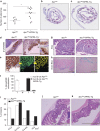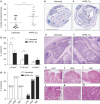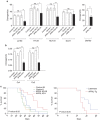The TNF family member APRIL promotes colorectal tumorigenesis
- PMID: 22705846
- PMCID: PMC3469063
- DOI: 10.1038/cdd.2012.68
The TNF family member APRIL promotes colorectal tumorigenesis
Abstract
The tumor necrosis factor (TNF) family member APRIL (A proliferation inducing ligand) is a disease promoter in B-cell malignancies. APRIL has also been associated with a wide range of solid malignancies, including colorectal cancer (CRC). As evidence for a supportive role of APRIL in solid tumor formation was still lacking, we studied the involvement of APRIL in CRC. We observed that ectopic APRIL expression exacerbates the number and size of adenomas in Apc(Min) mice and in a mouse model for colitis-associated colon carcinogenesis. Furthermore, knockdown of APRIL in primary spheroid cultures of colon cancer cells and both mouse and human CRC cell lines reduced tumor clonogenicity and in vivo outgrowth. Taken together, our data therefore indicate that both tumor-derived APRIL and APRIL produced by non-tumor cells is supportive in colorectal tumorigenesis.
Figures





References
-
- Dillon SR, Gross JA, Ansell SM, Novak AJ, An APRIL. to remember: novel TNF ligands as therapeutic targets. Nat Rev Drug Discov. 2006;5:235–246. - PubMed
-
- Medema JP, Planelles-Carazo L, Hardenberg G, Hahne M. The uncertain glory of APRIL. Cell Death Differ. 2003;10:1121–5. - PubMed
-
- Hendriks J, Planelles L, Jong-Odding J, Hardenberg G, Pals ST, Hahne M, et al. Heparan sulfate proteoglycan binding promotes APRIL-induced tumor cell proliferation. Cell Death Differ. 2005;12:637–648. - PubMed
Publication types
MeSH terms
Substances
LinkOut - more resources
Full Text Sources
Other Literature Sources
Medical
Molecular Biology Databases
Research Materials
Miscellaneous

